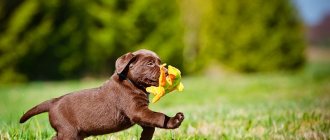A puppy's small age does not mean that he needs less attention and training.
Especially when it comes to German Shepherds.
This breed can become a true friend and protector.
But only if you start caring for and training him from a young age.
But this also has its own characteristics.
Let's find out about everything in detail.
Further in the article, detailed information on the care and education of a puppy will be provided.
What does a German Shepherd puppy look like at 3 months old?
At three months of age, a German Shepherd puppy begins to look more and more like an adult dog. His ears begin to stand up, his color gradually changes, his limbs begin to stretch out - his hind legs and large joints on his front legs grow.
The dog's tail also becomes more visible. The ears may still fall funny to the side, but most of the time they are now in an upright position.
At the same age, the puppy begins to shed.
In appearance, the dog still seems clumsy, parts of the body are disproportionate . This is due to the fact that the dog is entering adolescence and his body is just beginning to form.
This type of puppy indicates that maturation is in full swing. Over time, the awkwardness of his features will smooth out and cease to be so noticeable.
When do teeth change?
The replacement of baby teeth begins in shepherd dogs between 12-14 weeks. Itching in the oral cavity is possible; to reduce it, you can give the puppy rubber toys or large bones. This will also help get rid of already loose baby teeth.
Attention! Some dogs experience fever and lethargy when they change teeth. If you notice that your pet is feeling unwell, then reduce walks and active games. Protect from stressful situations
Protect from stressful situations.
If you notice that a baby tooth is very loose, you can remove it yourself. When removing, pull the tooth upward to prevent damage. Firmly seated teeth should not be removed, as fragments may remain in the gums.
The change of canines occurs at the age of 4 months. At the age of 10 months, all of the dog’s teeth are molars.
Dog character
Despite the beginning of maturation, the puppy still remains a mischievous child by nature.
He plays pranks with pleasure and prefers to play rather than listen to his owner and be trained . This is the time when you need to be persistent and show the puppy that he must obey his owner.
Things in the apartment - furniture or shoes - can suffer from the dog's behavior. Therefore, it is important to walk the dog as much as possible in special areas where the puppy can throw out all the hyperactivity.
This behavior is explained by post-vaccination quarantine . Once it comes to an end, it will be easier to deal with the dog.
Three months is the right time to teach your dog to react to passers-by, guests and other dogs. This will help build the dog's balance.
But you shouldn’t take her to places where there are a lot of loud and frightening sounds - the puppy’s psyche has not yet fully formed, such an environment can contribute to the dog becoming nervous and fearful.
Pet's height and weight
Even at such a young age, the first developments between boys and girls of the German Shepherd begin to take shape..
The height of a male at 3 months is 42-48 cm, and his weight is 14-14.2 kg. For a female, these indicators are as follows: height – 40-46 cm, weight – 12-12.3 kg.
Read more information about the height and weight of the German Shepherd here.
Although there is no noticeable difference in height, as can be seen from the parameters, the weight of puppies of different sexes differs significantly from each other.
CAREFULLY!
Deviation from standard indicators may be the beginning of any diseases or deviations in the puppy’s health.
If you notice a lack of weight or height, it is better to contact your veterinarian.
What time do your ears stand up?
Ears begin to stand up between 1.5 months and 5 months. Over time, the cartilage strengthens and the ears become larger. The change of teeth is directly related to the formation of the ears, so they can stand up at 2 months, and fall again by 3 months.
Observe the ears carefully from 5 to 6 months; if they are not erect by the age of six months, contact your veterinarian. After 7 months it is very difficult to place ears.
Why isn't this happening?
There are a number of reasons why German Shepherds' ears don't stand up:
- Not purebred shepherd. People are often deceived and sold non-purebred puppies. Such animals often have problems with the formation of ears. When purchasing, carefully check all documents for the dog.
- Insufficient amount of minerals. With poor nutrition and lack of essential substances, cartilage may not form properly.
- Ear diseases. Any inflammation can negatively affect the performance.
- Irregular fit or structure of the ears. Let's say the ears are very large and large or, on the contrary, thin. In this case, in order not to harm the animal, seek help from a veterinarian.
- Weak immunity and frequent illnesses. If your pet is often sick, he may not have enough nutrients to form cartilage.
How to install?
If your pet is more than 4 months old, and the ears are not set and are quite flaccid, you need to take action.
Massage the ears. Massage stimulates blood circulation, which will have a positive effect when performing. Sound
Unusual and unexpected sounds will attract the puppy's attention, and he will turn around and raise his ears fully for a while. Thanks to such training, the muscle tissue of the auricle will be strengthened and over time it will completely move to a vertical position. Balanced diet
If the dog lacks nutrients, then cartilage will not develop. The menu must include: fish, dairy products. Introduce fertilizers with sufficient amounts of microelements. Glue the ears. You will need foam rollers without plastic inserts and a patch. Try to choose a curler based on the size of your ear, as too large or small will bring less benefit. Insert the foam rubber into the auricle without covering the ear canal, secure with adhesive tape. Do not use tape - it can injure the puppy's skin. The structure must be removed after seven days. If there are no changes, repeat the procedure.
Important! If, after taking measures, the ears still do not stand up by 6 months, contact your veterinarian.
What is better – natural or dry food?
Every owner thinks about which food is best for a pet. The debate over natural food and dry food never subsides.
Each of these foods can meet the needs of the puppy, the main thing is to follow the most important instructions in feeding the dog:
- When choosing dry food, opt for premium or super-premium class;
- Try to choose food for your breed;
- The food must be suitable for the dog’s age;
- If you choose natural food, the dog’s diet should be balanced;
- Natural food will require special vitamins;
- You must approach the choice of products responsibly: buy only fresh ones, exclude those that will harm the dog.
Expert opinion
Kozhevin Semyon Kirillovich
Expert dog handler.
“Food for a puppy of this breed is a very important matter. I know that many owners who are professional breeders choose natural food, believing that it is healthier for the dog. But they have enough time to cook and buy all the necessary products. People who get a German Shepherd “for the soul, and not “for business”, prefer dry food. If the dog's nutrition is correct, then no matter what type of food you choose, the dog will be happy."
Physiological development
Alabai puppies in childhood look like beautiful, funny plush toys. Subsequently, they turn into devoted friends and fearless guards.
Turkmen Alabai, wolfhound or shepherd dog: description
Despite the fact that the growth and weight gain rates of puppies of this breed are different, there is still a certain dependence on the established parameters. When keeping an Alabai puppy, the owner is recommended to weigh and measure the body monthly. If signs of a significant lag or, conversely, excessive increase are detected, it is necessary to immediately adjust the pet’s diet and living conditions. In this matter, you can seek help from specialists.
Birth and first month of life
The weight of the Alabai at birth must be at least 350 g. Otherwise, the puppies are considered weak and are discarded. If the puppy does not have congenital pathologies, and also if the lactating bitch has a sufficient amount of milk, newborn Alabai gain an average of about 4-4.5 kg in the first month. An Alabai weighs from 4 to 5 kg per month, while the puppy’s height varies from 25 to 30 cm. Up to two months, the optimal feeding option is mother’s breast milk. From two weeks of age, complementary foods are introduced into the puppy's diet.
Important! It is not recommended to feed Alabai puppies with industrial food for up to three months. Newborn Alabai puppies weigh 350 g. Newborn Alabai puppies weigh 350 g.
Newborn Alabai puppies weigh 350 g
Two month
In Alabai puppies, from the second month of life, intensive growth of muscles and bones begins. This is precisely the consequence of rapid growth and weight gain. By the age of two months, the Alabai's height at the withers should be at least 35 cm, and its weight should vary from 9 to 10 kg.
At three months, the dog’s musculoskeletal system continues to develop. Alabai has been growing very rapidly for 4 months. Due to this, his limbs noticeably lengthen. At four months of age, the puppy already weighs about 30 kg, and the height at the withers varies from 50 to 55 cm.
From 6 months, muscle formation begins, and the puppy begins to grow in breadth. At this time, the dog’s weight can be from 35 to 50 kg, and its height can vary from 60 to 65 cm.
Alabai puppy at 2 months
Period from 9 to 12 months
Closer to the year, the growth of the skeleton and the formation of the chest are completed in Alabais. Subsequently, body weight increases due to muscle growth.
Note! At 9-10 months, the sex of the dog can be accurately determined by exterior differences. A dog of the Alabai breed weighs from 60 to 70 kg at 1 year old, its height varies from 70 to 80 cm depending on gender. A dog of the Alabai breed weighs from 60 to 70 kg at 1 year old, its height varies from 70 to 80 cm depending on gender
A dog of the Alabai breed weighs from 60 to 70 kg at 1 year old, its height varies from 70 to 80 cm depending on gender.
One year old Central Asian Shepherd
1-2 years
After dogs reach one year of age, the formation of exterior characteristics due to muscle development does not end. Often dog breeders are faced with the fact that the animal begins to lose height. This happens as a result of relaxation of the ligamentous apparatus. There is no need to worry about this, since closer to two years everything will return to normal, and as a result, a powerful dog with an outstanding appearance will grow up.
Two years and older
In males, the formation of the exterior can last up to 3-5 years. For bitches the situation is different. The process stops between 9 and 18 months. This happens during the first heat.
Important! Early mating is contraindicated for both sexes, as it negatively affects the development of the locomotor-muscular system. In dogs older than 2 years, muscle growth is completed and the nervous system finally matures. In dogs older than 2 years, muscle growth is completed and the nervous system finally matures
In dogs older than 2 years, muscle growth is completed and the nervous system finally matures.
Beginning dog breeders are often interested in how much an adult Alabai weighs. Depending on the gender, a dog can weigh from 65 to 80 kg, while its height at the withers reaches 70-80 cm. But, as practice shows, this is not the limit. Individuals whose height reached 98 cm were recorded.
White and red alabai
Basic feeding rules
Rules to follow when feeding a German Shepherd:
- To keep your puppy healthy, it is important to follow certain rules when feeding it;
- Food should be warm, not hot, and not from the refrigerator;
- There should be no large pieces in the bowl so that the puppy does not choke - German shepherds do not chew food, but swallow it immediately;
- You need to feed your dog at the same time, regularly;
- You cannot overfeed your dog. This can lead to dehydration and volvulus;
- The puppy should always have clean drinking water available.
What not to feed
Under no circumstances should you feed your dog the following foods:
- Pork meat,
- Any bones
- Pasta,
- Bakery,
- Oranges, tangerines and lemons,
- Sausages, bacon, sausages and small sausages,
- Candies and chocolate,
- Pickled vegetables,
- I eat with spices
- Highly salty and spicy foods
- Beans and peas.
Otherwise, this food can lead to serious consequences: diarrhea, vomiting, stomach pain and increased gas formation, dehydration.
Feeding with natural food
Your dog's menu should include a variety of grains, fruits, vegetables and meat.
Pork should not be given to your German Shepherd as it can lead to obesity..
At 3 months, the menu should contain as much meat as possible. Protein is the basis of growth for a growing organism. The menu should also include cereals and vegetables - carbohydrates and fiber.
The best choice of meat is lean beef - raw or boiled . The meat should be finely chopped; it is not recommended to give minced meat: it forms pieces and is not completely digested.
The puppy can also eat chicken, rabbit and turkey. It is better to give eggs with porridge and not very often.
The puppy will like meat broths . They can be added to cereals instead of milk.
You can give large beef bones that are difficult to chew. Chicken can damage the dog's oral mucosa.
Suitable cereals for a German Shepherd include buckwheat, rice, millet, rolled oats and semolina. It is better to give vegetables raw: this way they will not lose their vitamins.
But it can also be boiled as a filler for porridges. Suitable ones include beets, tomatoes, zucchini, cabbage, cucumbers and others. And the puppy will like berries and apples - they can be added to cottage cheese.
Fermented milk products on the shepherd's menu should include low-fat kefir, cottage cheese, curdled milk, yogurt, and fermented baked milk . It is better to avoid foods with high fat content.
How and how much to feed
Meals at the age of three months should be four times a day. The volume of food for each feeding should be 300-400 g.
The feeding process should not exceed fifteen minutes.
If there is food left in the bowl, reduce the portion. If, on the contrary, the dog licks it, this is a reason to think about increasing it. In any case, this must be agreed with your veterinarian.
Prohibited Products
Since dogs, and especially puppies, do not digest starch and lactose well, it is better not to give potatoes and milk at all. Like other dogs, German Shepherds cannot eat anything fried, smoked, pickled, sweet or floury.
Eliminate various sausages and poultry bones.
To avoid disturbing your dog's digestion, do not feed him food from the table..
Vitamin supplements
To prevent your puppy from developing vitamin deficiency, do not forget to give him fresh greens - parsley, green onions, lettuce, spinach, beet and carrot tops, scalded nettles.
For these purposes, both sprouted oats and sprouted millet are suitable in an amount of no more than one tablespoon per day.
Mineral supplements you can offer your puppy include meat and bone meal and crushed shells . For proper hair growth, pharmaceutical sulfur is given, and yeast is given for digestion and appetite.
You can give your pet special vitamins and granules, but before doing this you should consult a specialist.
Separate food
A prerequisite is separate feeding. There is no need to create a vinaigrette by trying to feed meat, eggs, and soaked food in a small portion at the same time.
Cottage cheese and porridge must be present in the puppy's complementary foods
The stomach of a small puppy is not capable of producing many digestive enzymes, and each type of food requires its own composition of gastric juice.
The imperfection of the stomach of a one-month-old shepherd dog does not allow it to tune in to produce the necessary enzyme if the food has a multi-species composition. Such food lies in a lump at the bottom of the stomach and lingers there for a long time.
The result is vomiting or diarrhea, when the lump nevertheless pushes into the intestines. There will be no benefit from such complementary foods, but indigestion or persistent refusal to eat is easy.
This does not happen when different types of food are taken separately, because the ventricle is able to cope separately with porridge, separately with meat, separately with cottage cheese.
Feeding dry food
How to choose?
When choosing food, immediately exclude all cheap ones. They will not be able to provide the puppy with all the vitamins and nutrients necessary for growth and development. Very often, abuse of such feeds leads to diseases in animals. The kidneys, liver and stomach suffer.
IMPORTANT!
You need to buy premium or super-premium food. They are not cheap, but they will help save a lot of time and will not harm the dog’s health.
If there is a lack of calcium, the puppy's ears begin to fall off..
Popular manufacturers:
- Acana;
- GO Natural;
- Grandorf;
- Orijen;
- Dukes Farm;
- Bosh;
- Eukanuba;
- Arden Grange.
How often to feed
Feeding your dog, as with natural food, is 4 times a day..
It is advisable to do this after a walk. Then let the puppy rest for several hours so that the food is digested.
Fetal period
The fetal period is a period of time starting from the second half of pregnancy (approximately 32 days). It is called so because, starting from this period, embryos are already called fetuses.
Fifth week
By the fifth week, the embryos already reach a size of up to 3 centimeters. In weight, they make up about 20-25 percent of the total body weight of already born puppies. You may notice that the dog wants to eat more, the belly is already more noticeable.
Sixth week
During the sixth week, the organs of the heart, lungs, kidneys, liver, and eyes are already fully developed in small fetuses. The vertebral system, bones of the fore and hind limbs are also formed. The approximate size of the puppy is 6.5-7 centimeters. Due to the increasing enlargement of the uterus and its pressure on the bladder, the dog will go to the toilet more often.
Seventh week
During the seventh week of pregnancy, puppies already reach 9.5-10 centimeters in size. The bitch's belly increases quite noticeably and has a rounded shape. She begins preparations for childbirth: she arranges a place for her children, and gets more rest. At about 50 days, the fruits are already 12 centimeters in length. By weight, they already reach 75 percent of the total weight at birth.
Eighth and ninth weeks
During the eighth and ninth weeks, the expectant mother sleeps more and more. She needs a reserve of strength before an important and difficult event - childbirth. Puppies in the uterus already reach a length of 15 centimeters. They develop chewing organs and teeth.
After the 58th day of a dog’s pregnancy, the owner needs to be in full combat readiness, because the shepherd dog can give birth at any moment.
If the shepherd has not given birth after 60 days, then the puppies in the womb are already completely ready to be born. They already have hair and range from 18 to 23 centimeters in length. Their weight ranges from 350 to 550 grams.
Young mother dogs before their first birth are worried in every possible way and try to notify their owner about this. They want to hide somewhere, digging the ground underneath them, as if making a lair until 1.5 days before the upcoming fights.
In order to understand in time that labor is about to begin, it is necessary to regularly measure your pet’s body temperature. The day before birth, it drops noticeably to 36.3 to 37.2 degrees Celsius.
Do I need to get vaccinated at this age?
The only vaccination that should be done after three months is against rabies. All other vaccinations are distributed throughout the dog’s life so that nothing serious occurs at this age .
Vaccinations have either already been done or the deadline for them has not yet come.
But sometimes it happens that the puppy’s second vaccination falls at three months. It depends on the age at which the first one was performed.
Shepherd named Stefanitsa
One of the most important events in the history of the formation of the German Shepherd breed was an exhibition in the modest German town of Karlsruhe, which a certain Max von Stefanitz accidentally visited with his friend.
Being a retired military man, Max devoted all his free time to breeding German shepherds and, of course, immediately drew attention to the ideal external characteristics of one of the dogs. After lengthy negotiations with the animal’s owner, who did not want to immediately part with the pet, von Stephanitz began breeding dogs with the participation of the ideal “German”
The efforts of the breeder were rewarded by a sufficient number of worthy representatives of the breed, so that most of the modern purebred branches of the German Shepherd are, in one way or another, associated with the names of the animals that appeared as a result of Stefanitz’s activities.
Caring for a three month old puppy
Three months is the age when walking the dog should be in full swing. The first walks should not exceed five minutes, then gradually increase to 30-40 minutes.
If at first you need to hold the puppy in your arms, then teach him to walk on his own, make sure that he does not pick up anything from the ground.
Train him to use a leash, because large dogs like the German Shepherd cannot be walked without a leash, no matter how well trained he is.
NOTE!
A full walk should consist of communication with peers, games and jogging.
At this time, the puppy should know some commands and get used to using the toilet outside.
Dog hygiene consists of brushing, which should occur 1-2 times a week, cleaning the ears and trimming the nails . Puppies should be bathed when the smell begins to appear or as they become dirty.
How to distinguish a breed from a crossbreed or mongrel
The surest way to purchase a purebred German Shepherd is to do so from a reliable kennel. Then the puppy will have a pedigree, a metric (puppy card), a brand with a unique number in the groin or on the ear. And you won’t have to guess whether you bought a purebred dog or not. When buying from private breeders or on the market, there is always a risk of making a mistake, because an amateur is unlikely to be able to correctly evaluate the breed. In this case, decide on the purpose: why you need a dog. To participate in exhibitions and breeding work, you need to look for a puppy only in nurseries with a good reputation. For official or security work - in the same place, because the character of a real German Shepherd, which made it a legend and a movie star, is also a sign of the breed. But then appearance is not so important, and the dog will cost much less.
The new owner signs the puppy inspection report (below) and the certificate is certified with a seal
If you want to have a companion dog with the appearance of a German Shepherd, then you can take the risk of purchasing it on the market or through “buy and sell” advertisements, but at the same time remember that a grown-up pet may unpleasantly surprise you with its difference from true “Germans”. There are signs by which you can try to distinguish a purebred puppy from a mestizo or mongrel:
- “Germans” have almond-shaped eyes with snow-white whites, while mongrel dogs have round, sometimes convex, eyes with yellowish whites or dark spots;
- an ordinary puppy cannot boast of a perfectly smooth topline and a body elongated like a torpedo;
- the tail of a small shepherd never rises above the line of the back and does not curl into a ring, like that of mongrels;
- The ears of a “German” should be floppy and soft for at least 4–5 months, while a mongrel’s ears may stand up at any time or not at all;
- A purebred baby does not have a stripe between the eyebrows (frontal furrow) on the forehead, but a purebred baby may have one;
- A shepherd puppy grows and develops much faster than a yard puppy, so at the same age he will weigh more and look more mature.
A “German” puppy is more inclined to communicate with a person than a mongrel puppy
Video: how to choose the right German Shepherd
Training and education
Three months is the time to start serious training, given that the dog has already learned the basic commands. These are “sit”, “lie”, “place” and “near”.
During the training process, you must not insult, humiliate or beat the dog..
She won't respect you if you are rude to her. Real authority can be shown without this, but the puppy will remember this and begin to fear you, not respect you. Trust cannot be built on fear.
Show the puppy that if he follows the command correctly, he will receive a reward, otherwise he will receive a reprimand . Also, before training, the dog should be in a good mood - he should not want to go to the toilet, not be hungry or overexcited.
Also schedule a time when you will do your workouts. You should always hold this time in the future so that the puppy gets used to it - it’s not time for games.
You also need to train in different places, not just in an apartment or in one place on the street. This way the puppy will understand that it is necessary to obey and carry out commands not only in one location.
In addition to the basic commands, the puppy must learn the commands “No”, “Fu”, “Bring”, “Own”, “Alien” . The dog easily gets used to the commands “Eat” and “Walk”.
It is the persistence and conscientiousness of the owner that determines how the dog will grow up. Owning a German Shepherd is a big responsibility.
Without training and education, it can become a great threat to others..
Behavior
If up to 3 months the German Shepherd puppy was exploring the world, trying to get to know all the animals and strangers, now he behaves more warily and closely monitors the actions of people and other pets.
The shepherd seems to be on the defensive and can even run away from an object that is “suspicious” to it and hide from it, watching the “enemy” from cover.
Sometimes a dog may start barking and grinning at a stranger or another dog. In this case, the owner must calm the pet by saying the command “Fu” and “No”, loudly calling the shepherd by name. This way she will understand that other people and animals are not dangerous, but she will still be wary.
After all, a shepherd is a good guard, and the protective instinct is in its blood.











